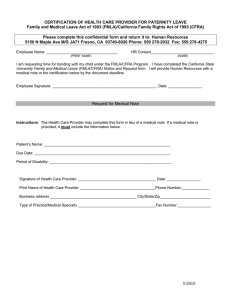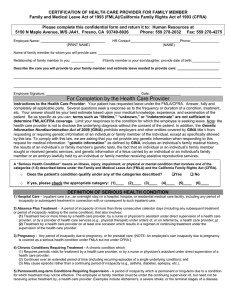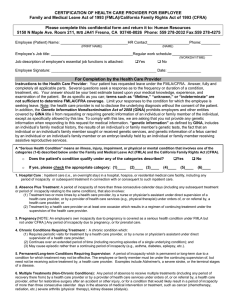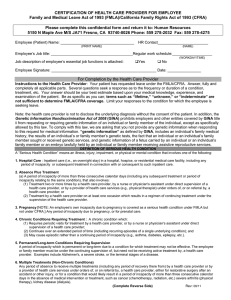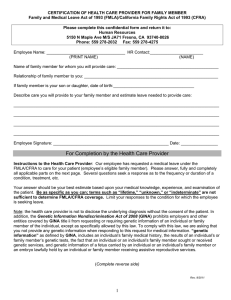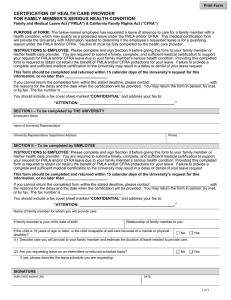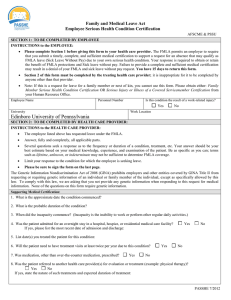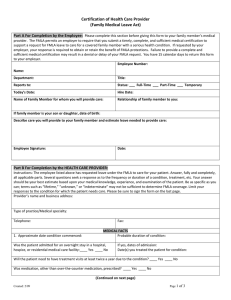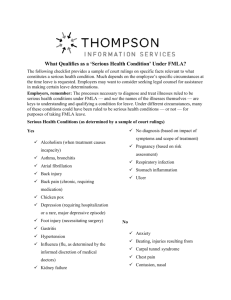CERTIFICATION OF HEALTH CARE PROVIDER FOR EMPLOYEE’S SERIOUS HEALTH CONDITION
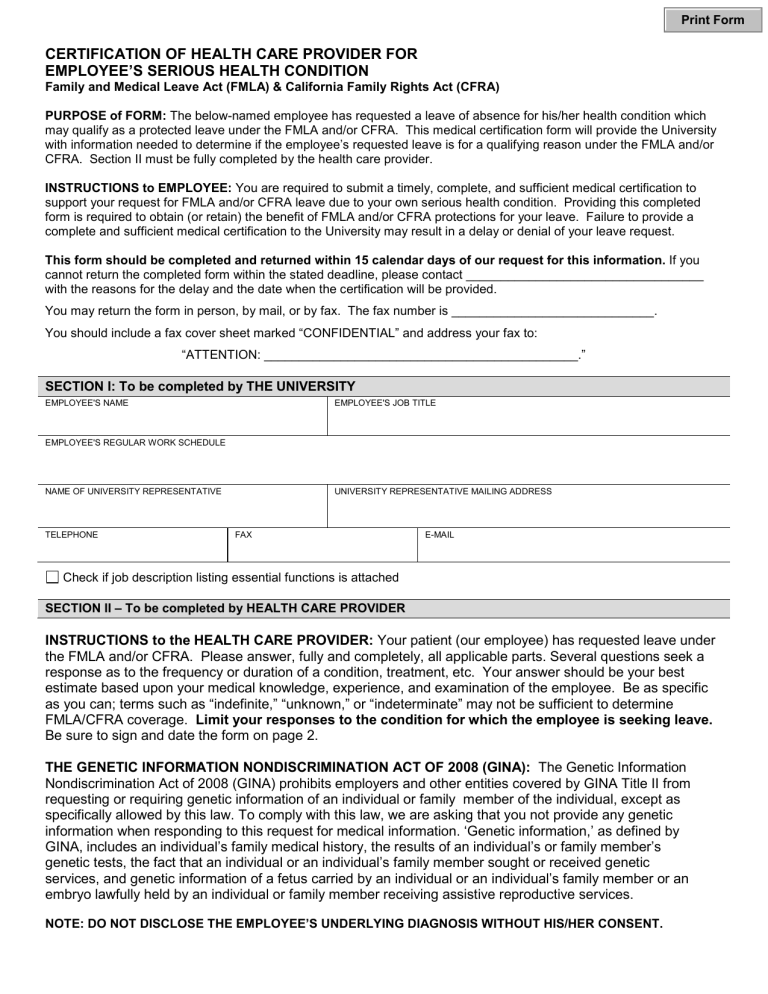
Print Form
CERTIFICATION OF HEALTH CARE PROVIDER FOR
EMPLOYEE’S SERIOUS HEALTH CONDITION
Family and Medical Leave Act (FMLA) & California Family Rights Act (CFRA)
PURPOSE of FORM:
The below-named employee has requested a leave of absence for his/her health condition which may qualify as a protected leave under the FMLA and/or CFRA. This medical certification form will provide the University with information needed to determine if the employee’s requested leave is for a qualifying reason under the FMLA and/or
CFRA. Section II must be fully completed by the health care provider.
INSTRUCTIONS to EMPLOYEE:
You are required to submit a timely, complete, and sufficient medical certification to support your request for FMLA and/or CFRA leave due to your own serious health condition. Providing this completed form is required to obtain (or retain) the benefit of FMLA and/or CFRA protections for your leave. Failure to provide a complete and sufficient medical certification to the University may result in a delay or denial of your leave request.
This form should be completed and returned within 15 calendar days of our request for this information.
If you cannot return the completed form within the stated deadline, please contact __________________________________ with the reasons for the delay and the date when the certification will be provided.
You may return the form in person, by mail, or by fax. The fax number is _____________________________.
You should include a fax cover sheet marked “CONFIDENTIAL” and address your fax to:
“ATTENTION: _____________________________________________.”
SECTION I: To be completed by THE UNIVERSITY
EMPLOYEE'S NAME EMPLOYEE'S JOB TITLE
EMPLOYEE'S REGULAR WORK SCHEDULE
NAME OF UNIVERSITY REPRESENTATIVE
TELEPHONE
UNIVERSITY REPRESENTATIVE MA I LING ADDRESS
E-MAIL FAX
Check if job description listing essential functions is attached
SECTION II – To be completed by HEALTH CARE PROVIDER
INSTRUCTIONS to the HEALTH CARE PROVIDER:
Your patient (our employee) has requested leave under the FMLA and/or CFRA. Please answer, fully and completely, all applicable parts. Several questions seek a response as to the frequency or duration of a condition, treatment, etc. Your answer should be your best estimate based upon your medical knowledge, experience, and examination of the employee. Be as specific as you can; terms such as “indefinite,” “unknown,” or “indeterminate” may not be sufficient to determine
FMLA/CFRA coverage.
Limit your responses to the condition for which the employee is seeking leave.
Be sure to sign and date the form on page 2.
THE GENETIC INFORMATION NONDISCRIMINATION ACT OF 2008 (GINA):
The Genetic Information
Nondiscrimination Act of 2008 (GINA) prohibits employers and other entities covered by GINA Title II from requesting or requiring genetic information of an individual or family member of the individual, except as specifically allowed by this law. To comply with this law, we are asking that you not provide any genetic information when responding to this request for medical information. ‘Genetic information,’ as defined by
GINA, includes an individual’s family medical history, the results of an individual’s or family member’s genetic tests, the fact that an individual or an individual’s family member sought or received genetic services, and genetic information of a fetus carried by an individual or an individual’s family member or an embryo lawfully held by an individual or family member receiving assistive reproductive services.
NOTE: DO NOT DISCLOSE THE EMPLOYEE’S UNDERLYING DIAGNOSIS WITHOUT HIS/HER CONSENT.
PROVIDER'S NAME
BUSINESS ADDRESS
TELEPHONE FAX
PART A: MEDICAL FACTS
(1) Approximate date condition commenced:
__________________
Probable duration of condition:
From: __________________ To: __________________
(2) Page 3 describes what is meant by a “serious health condition” under both the FMLA and CFRA.
Does the employee’s condition qualify as one of the types of serious health conditions described?
If yes, which type of serious health condition listed on Page 3 applies:
1 2 3 4 5 6
Yes No
(3) Use the information provided by the University in Section I to answer these questions. If no job description has been provided, please answer these questions based upon the employee’s own description of his/her job functions.
Is the employee able to perform work of any kind?
Yes No
If yes, is the employee unable to perform one or more of the essential functions of his/her position due to the condition? (Answer “yes” if intermittent or reduced schedule leave is medically necessary.)
Yes No
PART B: AMOUNT OF LEAVE NEEDED
(4) Will the employee be incapacitated for a single continuous period of time due to his/her medical condition, including any time for treatment and recovery?
If yes, estimate the beginning and ending dates for the period of incapacity:
FROM TO
Yes No
Answer questions 5 and/or 6 only if the employee requires leave on an intermittent or reduced schedule basis.
(5) Will it be medically necessary for the employee to leave work intermittently or work a reduced schedule as a result of the medical condition (other than for episodic flare-ups which are addressed in question #6 below)?
Yes No
If the employee needs reduced schedule leave, estimate the part-time or reduced work schedule the employee needs:
Employee should work no more than:
_______ Hours per Day _______ Days Per Week From: __________________ through: __________________
If the employee needs intermittent leave, estimate the frequency of need for intermittent leave and the duration of incapacity (e.g. 1 episode every 3 months lasting 1-2 days):
Frequency: ____ Times per week(s) month(s) Duration: ____ Hours or ____ Day(s) per episode
(6) Will the medical condition cause episodic flare-ups that will make it medically necessary for the employee to leave work intermittently or work a reduced schedule?
Yes No
If yes, based upon the patient’s medical history and your knowledge of the medical condition, estimate the frequency of flare-ups, the likely duration of incapacity that the patient may have as a result, and the period during which the flare-ups may occur (e.g., 1 episode every 3 months lasting 1-2 days during the specified period):
Frequency: ____ Times per week(s) month(s) Duration: ____ Hours or ___ Day(s) per episode
Flare-ups may occur from: __________________ through: __________________
Part C: SIGNATURE
SIGNATURE OF HEALTH CARE PROVIDER DATE
Print Form
Serious Health Conditions
A “serious health condition” means an illness, injury, impairment, or physical or mental condition that involves one of the following:
1. Inpatient Care
Inpatient care (i.e., an overnight stay) in a hospital, hospice, or residential medical care facility, including any period of incapacity or subsequent treatment in connection with or consequent to such inpatient care.
2. Incapacity of More Than 3 Consecutive Days Plus Continuing Treatment by a Health Care Provider
A period of incapacity of more than three consecutive calendar days (including any subsequent treatment or period of incapacity relating to the same condition), that also involves:
(a) Treatment two or more times by a health care provider, by a nurse or physician’s assistant under direct supervision of a health care provider, or by a provider of health care services (e.g., physical therapist) under orders of, or on referral by, a health care provider; OR
(b) Treatment by a health care provider on at least one occasion which results in a regimen of continuing treatment under the supervision of the health care provider (e.g., a course of prescription medication, or therapy requiring special equipment, to resolve or alleviate the health condition). Note: This does not include taking over-the-counter medications or activities that can be initiated without a visit to a health care provider (e.g., bed rest, exercise, drinking fluids).
3. Pregnancy (only covered under FMLA)
A period of incapacity due to pregnancy, childbirth, or related medical conditions. This includes severe morning sickness and prenatal care.
4. Chronic Conditions Requiring Treatment
A chronic condition which:
(a) Requires periodic visits for treatment by a health care provider, or by a nurse or physician’s assistant under direct supervision of a health care provider;
(b) Continues over an extended period of time (including recurring episodes of a single underlying condition); and
(c) May cause episodic rather than a continuing period of incapacity (e.g., asthma, diabetes, epilepsy, etc.).
5. Permanent/Long-Term Conditions Requiring Supervision
A period of incapacity that is permanent or long-term due to a condition for which treatment may not be effective.
The employee or family member must be under the continuing supervision of, but need not be receiving active treatment by, a health care provider. Examples include Alzheimer’s, a severe stroke, or the terminal stages of a disease.
6. Multiple Treatments (Non-Chronic Conditions)
Any period of absence to receive multiple treatments (including any period of recovery therefrom) by a health care provider or by a provider of health care services under orders of, or on referral by, a health care provider, either for restorative surgery after an accident or other injury, or for a condition that would likely result in a period of incapacity of more than three consecutive calendar days in the absence of medical intervention or treatment, such as cancer (chemotherapy, radiation, etc.) severe arthritis (physical therapy), or kidney disease (dialysis).
